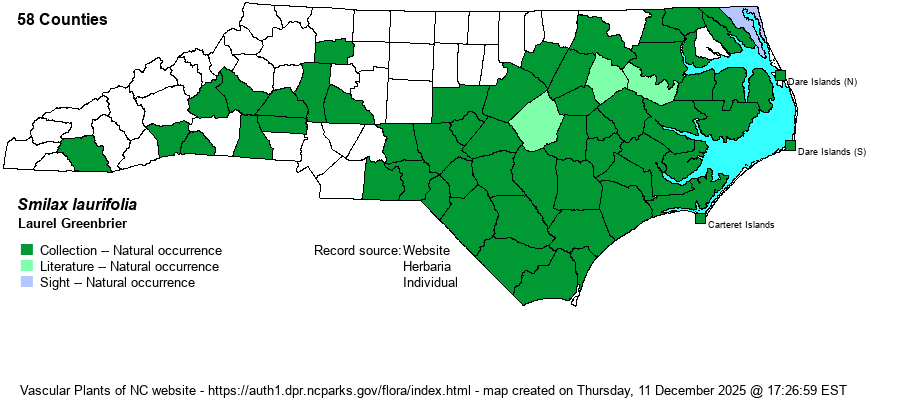| Author | L. | |
| Distribution | Essentially throughout the Coastal Plain (though scarce in the northwestern portions), and sparingly in the eastern and southern Piedmont and southern Mountains. Practically no records in the northern Piedmont and northern Mountains.
A Southern species, occurring from NJ south, mostly in the Coastal Plains to southern FL and eastern TX. It is not found in WV and KY and occurs only in far southeastern TN.
| |
| Abundance | Common to abundant in the southern and eastern Coastal Plain, including the Sandhills. Fairly common to locally common over the northern Coastal Plain, but scarce in the counties along the Roanoke River. Rare to locally uncommon in far eastern Piedmont counties, as well as in the southwestern Piedmont. Rare in the southern Mountains. | |
| Habitat | This is a well-known plant of acidic wetlands -– especially prominent in pocosins, bays, streamheads, and some acidic swamps. In the Piedmont it occurs mostly along small forested streams and streamheads in areas of acidic soils. It occurs in seepage bogs in the Mountains. |
| Phenology | Flowers in July and August; fruits in September and October of the following year. The berries take about 14 months to mature. | |
| Identification | This is a very strong and robust, high-climbing evergreen vine, as anyone who has explored in the Sandhills and in pocosins knows first-hand. The leaves are very thick and leathery, being elliptical or more frequently oblong (leaf sides are often parallel), somewhat rounded at the tip, and about 3-4 inches long. Leaves are commonly 1.5-2 inches wide, but may range up to 3 inches. Though the stems do have some strong thorns, the sturdy vines can grow so thickly over other vegetation that it is the stems themselves, and not the thorns, that deter most human passage through pocosins and streamheads. Because the berries take so long to mature, one often sees pale green, immature berries on the vines in fall and winter. Of the native plant species, this along with Poison-ivy (Toxicodendron radicans) and a few blackberries (Rubus spp.) are the most disliked in terms of deterrents to field work! | |
| Taxonomic Comments | None
| |
| Other Common Name(s) | Laurel-leaf Greenbrier, Bamboo-vine, Blaspheme-vine | |
| State Rank | S5 | |
| Global Rank | G5 | |
| State Status | | |
| US Status | | |
| USACE-agcp | FACW link |
| USACE-emp | OBL link |

